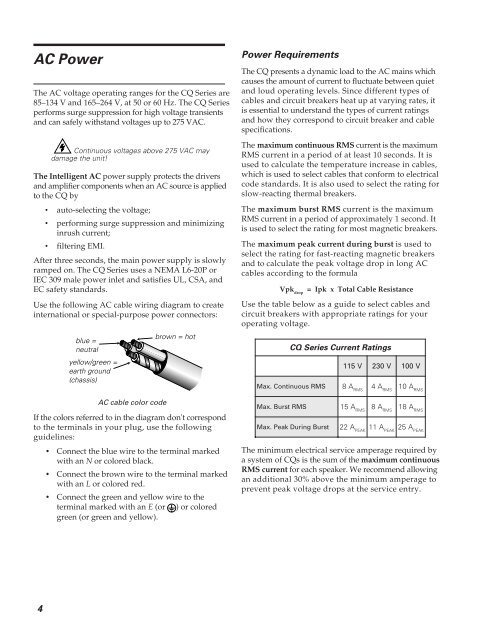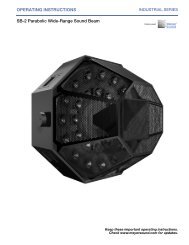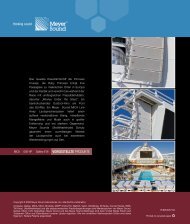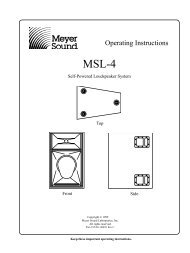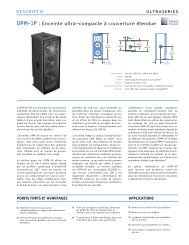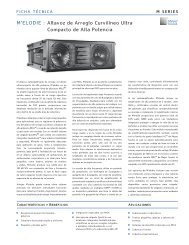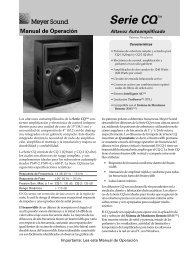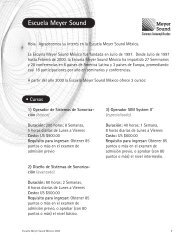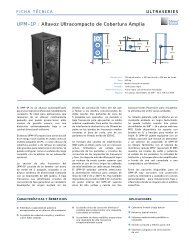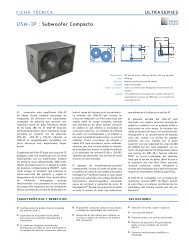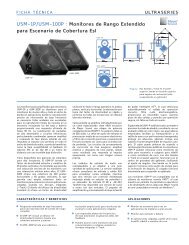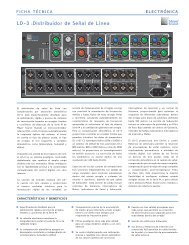Operating Instructions CQ Series - Meyer Sound Laboratories Inc.
Operating Instructions CQ Series - Meyer Sound Laboratories Inc.
Operating Instructions CQ Series - Meyer Sound Laboratories Inc.
You also want an ePaper? Increase the reach of your titles
YUMPU automatically turns print PDFs into web optimized ePapers that Google loves.
AC Power<br />
The AC voltage operating ranges for the <strong>CQ</strong> <strong>Series</strong> are<br />
85–134 V and 165–264 V, at 50 or 60 Hz. The <strong>CQ</strong> <strong>Series</strong><br />
performs surge suppression for high voltage transients<br />
and can safely withstand voltages up to 275 VAC.<br />
4<br />
Continuous voltages above 275 VAC may<br />
damage the unit!<br />
The Intelligent AC power supply protects the drivers<br />
and amplifier components when an AC source is applied<br />
to the <strong>CQ</strong> by<br />
• auto-selecting the voltage;<br />
• performing surge suppression and minimizing<br />
inrush current;<br />
• filtering EMI.<br />
After three seconds, the main power supply is slowly<br />
ramped on. The <strong>CQ</strong> <strong>Series</strong> uses a NEMA L6-20P or<br />
IEC 309 male power inlet and satisfies UL, CSA, and<br />
EC safety standards.<br />
Use the following AC cable wiring diagram to create<br />
international or special-purpose power connectors:<br />
blue =<br />
neutral<br />
yellow/green =<br />
earth ground<br />
(chassis)<br />
AC cable color code<br />
brown = hot<br />
If the colors referred to in the diagram don't correspond<br />
to the terminals in your plug, use the following<br />
guidelines:<br />
• Connect the blue wire to the terminal marked<br />
with an N or colored black.<br />
• Connect the brown wire to the terminal marked<br />
with an L or colored red.<br />
• Connect the green and yellow wire to the<br />
terminal marked with an E (or ) or colored<br />
green (or green and yellow).<br />
Power Requirements<br />
The <strong>CQ</strong> presents a dynamic load to the AC mains which<br />
causes the amount of current to fluctuate between quiet<br />
and loud operating levels. Since different types of<br />
cables and circuit breakers heat up at varying rates, it<br />
is essential to understand the types of current ratings<br />
and how they correspond to circuit breaker and cable<br />
specifications.<br />
The maximum continuous RMS current is the maximum<br />
RMS current in a period of at least 10 seconds. It is<br />
used to calculate the temperature increase in cables,<br />
which is used to select cables that conform to electrical<br />
code standards. It is also used to select the rating for<br />
slow-reacting thermal breakers.<br />
The maximum burst RMS current is the maximum<br />
RMS current in a period of approximately 1 second. It<br />
is used to select the rating for most magnetic breakers.<br />
The maximum peak current during burst is used to<br />
select the rating for fast-reacting magnetic breakers<br />
and to calculate the peak voltage drop in long AC<br />
cables according to the formula<br />
Vpk drop = Ipk x Total Cable Resistance<br />
Use the table below as a guide to select cables and<br />
circuit breakers with appropriate ratings for your<br />
operating voltage.<br />
<strong>CQ</strong><br />
S<br />
eries<br />
Current<br />
Max. Continuous<br />
RMS<br />
A<br />
R<br />
atings<br />
115 V 230 V 100<br />
V<br />
8 RMS<br />
Max. Burst<br />
RMS<br />
5 A<br />
1 RMS<br />
Max. Peak<br />
During<br />
Burst<br />
2 A<br />
4 ARMS<br />
8 ARMS<br />
10 ARMS<br />
18 ARMS<br />
2 11 A 25 A<br />
PEAK<br />
PEAK<br />
PEAK<br />
The minimum electrical service amperage required by<br />
a system of <strong>CQ</strong>s is the sum of the maximum continuous<br />
RMS current for each speaker. We recommend allowing<br />
an additional 30% above the minimum amperage to<br />
prevent peak voltage drops at the service entry.


